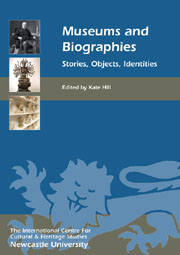Book contents
- Frontmatter
- Contents
- List of Illustrations
- Introduction: Museums and Biographies – Telling Stories about People, Things and Relationships
- INDIVIDUAL BIOGRAPHY AND MUSEUM HISTORY
- PROBLEMATISING INDIVIDUALS' BIOGRAPHIES
- INSTITUTIONAL BIOGRAPHIES
- OBJECT BIOGRAPHIES
- MUSEUMS AS BIOGRAPHY
- MUSEUMS AS AUTOBIOGRAPHY
- 19 Autobiographical Museums
- 20 Who is History? The Use of Autobiographical Accounts in History Museums
- 21 Community Biographies: Character, Rationale and Significance
- Endpiece: The Homunculus and the Pantograph, or Narcissus at the Met
- List of Contributors
- Index
19 - Autobiographical Museums
from MUSEUMS AS AUTOBIOGRAPHY
Published online by Cambridge University Press: 05 February 2013
- Frontmatter
- Contents
- List of Illustrations
- Introduction: Museums and Biographies – Telling Stories about People, Things and Relationships
- INDIVIDUAL BIOGRAPHY AND MUSEUM HISTORY
- PROBLEMATISING INDIVIDUALS' BIOGRAPHIES
- INSTITUTIONAL BIOGRAPHIES
- OBJECT BIOGRAPHIES
- MUSEUMS AS BIOGRAPHY
- MUSEUMS AS AUTOBIOGRAPHY
- 19 Autobiographical Museums
- 20 Who is History? The Use of Autobiographical Accounts in History Museums
- 21 Community Biographies: Character, Rationale and Significance
- Endpiece: The Homunculus and the Pantograph, or Narcissus at the Met
- List of Contributors
- Index
Summary
By an autobiographical museum I mean a museum of which the principal subject is the story of the life and/or career of the person who established the museum. Many of these museums are well known, but the autobiographical museum as a distinct genre has been given little scholarly attention.
Although it can be argued that all personal collecting is an exercise in self-expression and identity-formation, not all personal collecting is autobiographical. Conversely, some highly personal collections, dwellings or environments arranged for the purpose of permanent public display were not dubbed ‘museums’ by their creators but can be characterised as autobiographical museums. Other collections include a specifically autobiographical element but go well beyond this in scope and ambition; Henry Ford, for example, began his collecting by re-purchasing his own Quadricycle, acquiring children's readers of the type he had used at school, relocating his family farmhouse and then excavating the site for remnants of his childhood. Later he built a scale replica of his first assembly plant and relocated the mill where he and his father had taken the wool from their farm. Although Ford's Greenfield Village and its associated folk museum eventually grew into something broader in scope and larger in scale, its nostalgic autobiographical origins were significant in defining its character (Kaufman 1989, 36–8).
The various types of autobiographical museum tell, or illustrate, their maker's life-story in different ways, and although ‘autobiographical’ is a convenient term by which to identify these museums or collections as a genre, the analogy with the typical book-length, chronological, written autobiography is not always a close one.
- Type
- Chapter
- Information
- Museums and BiographiesStories, Objects, Identities, pp. 279 - 294Publisher: Boydell & BrewerPrint publication year: 2012



